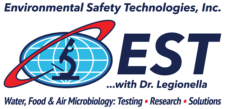Candida auris (C. auris) is a yeast that erodes a host’s innate immunity and also possesses multi-drug resistance. C. auris was first identified in 2009 in Japan (CDC.gov, n.d.; Weerasinghe et al., 2023) and has been present in the United States since 2013. C. auris is one of the leading causes of invasive candidiasis, a healthcare-acquired infection (HAI) that often presents in immunocompromised individuals. Treatment of invasive candidiasis caused by C. auris is profoundly difficult. C. auris can easily be misidentified as other Candida species, and due to its multi-drug resistance, the effectiveness of most antifungals is limited. This presents a difficult scenario in which a patient infected with C. auris could be subject to delayed and ineffective treatment. All these factors may contribute to the high mortality rate of 52.5% that has been observed so far, according to the National Library of Medicine. Here is what you need to know and how waterborne pathogen testing can help.
Who Is at Risk?
Risks associated with C. auris include exposure in healthcare settings, especially patients who have had long hospitalizations, recent surgical procedures, use of broad-spectrum antibiotics, and invasive devices (Caceres et al., 2019; CDC.gov, n.d.). Pre-existing conditions such as diabetes, chronic kidney disease, and being immunocompromised also increase the risk of C. auris infection (Sikora, Hashmi, and Zahra, 2023). Therefore, it would be prudent to consider healthcare wards such as ICUs, NICUs, Oncology, and surgical in-patient units as potential high-risk areas for both infection and environmental contamination. Contact a waterborne pathogen testing service for more information.
How Can I Prevent an Outbreak in My Facility?
To effectively minimize contamination in your healthcare facility, it is important to first understand the epidemiology of C. auris within the environment of care. At the time of this writing, it is believed that C. auris’s primary mode of transmission is by contact, via person to person, or from environment to person (CDC.gov, n.d.). Several studies have implicated both methods of transmission as being responsible for outbreaks within a healthcare facility (Biswal et al., 2017).
Strong infection prevention practices can minimize contamination from C. auris in your healthcare facility. Appropriate hand hygiene per CDC recommendations has been found to be effective in decontaminating C. auris from healthcare workers’ hands (Biswal et al., 2017). Environmental surveillance and decontamination are also recommended for the prevention of C. auris (Biswal et al., 2017; Hubert et al., 2020). Environmental surveillance can take the form of regular testing of potential reservoirs of C. auris within the care environment, such as within the facility’s water network (Hubert et al., 2020). Contact Environmental Safety Technologies, Inc for the waterborne pathogen testing you need. We can also provide an indoor air quality assessment. In case of an outbreak, rapid response through surface sampling of suspect areas can prevent further infections from an environmental source.
References
Biswal, M., Rudramurthy, S. M., Jain, N., Shamanth, A. S., Sharma, D., Jain, K., Yaddanapudi, L. N., & Chakrabarti, A. (2017). Controlling a possible outbreak of Candida auris infection: Lessons learnt from multiple interventions. Journal of Hospital Infection, 97(4), 363–370. https://doi.org/10.1016/j.jhin.2017.09.009
Caceres, D. H., Forsberg, K., Welsh, R. M., Sexton, D. J., Lockhart, S. R., Jackson, B. R., & Chiller, T. (2019). Candida auris: A review of recommendations for detection and control in healthcare settings. Journal of Fungi, 5(4), 111. https://doi.org/10.3390/jof5040111
General information about candida auris | candida auris | fungal diseases | CDC. (n.d.). Centers for Disease Control and Prevention. https://www.cdc.gov/fungal/candida-auris/candida-auris-qanda.html
Hubert, F., Rodier, M. ‐., Minoza, A., Portet‐Sulla, V., Cateau, E., & Brunet, K. (2020). Free‐living amoebae promote Candida auris survival and proliferation in water. Letters in Applied Microbiology, 72(1), 82–89. https://doi.org/10.1111/lam.13395
Sikora A, Hashmi MF, Zahra F. Candida Auris. [Updated 2023 Feb 19]. In: StatPearls [Internet]. Treasure Island (FL): StatPearls Publishing; 2023 Jan-. Available from: https://www.ncbi.nlm.nih.gov/books/NBK563297/
Weerasinghe, H., Simm, C., Djajawi, T., Tedja, I., Lo, T. L., Shasha, D., Mizrahi, N., Olivier, F. A., Speir, M., Lawlor, K. E., Ben-Ami, R., & Traven, A. (2023). Candida auris evades innate immunity by using metabolic strategies to escape and kill macrophages while avoiding antimicrobial inflammation. Biorxiv. https://doi.org/10.1101/2023.02.28.529319
Al-Rashdi, A., Al-Maani, A., Al-Wahaibi, A., Alqayoudhi, A., Al-Jardani, A., & Al-Abri, S. (2021). Characteristics, Risk Factors, and Survival Analysis of Candida auris Cases: Results of One-Year National Surveillance Data from Oman. Journal of Fungi, 7(1). https://www.ncbi.nlm.nih.gov/pmc/articles/PMC7825686/

